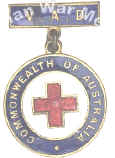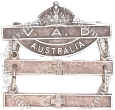They were not employed in military
hospitals, except as ward and pantry maids; rather, they worked in Red
Cross convalescent and rest homes, canteens, and on troop trains.
 |
 |
 |
L
to R. These 3 badges are all for members of
the Voluntary Aid Detachment (VAD); tie pin, shoulder title and
long service badge (1 bar per year) |
At the start of the First World War,
Australian VADs were restricted from traveling overseas by the Defence
Council. As a result, many chose to travel on their own initiative and
join British detachments, often in Australian Hospitals. It is reported
that the 1st Australian Auxiliary Hospital included in their nursing
staff some 120 VADs, chiefly Australians in the British service,
employed through the Australian Red Cross Society. This policy was
changed in 1916 after a request from Great Britain, and the first
attachment of thirty official Australian VADs to serve overseas left
Australia in September 1916.
The role of VADs did not significantly
evolve between the wars. VADs in the Second World War were given more
medical training, but they were not fully qualified nurses. They worked
in convalescent hospitals, on hospital ships and the blood bank as well
as on the home front. In 1943, the government created the Australian
Women’s Auxiliary Service (AWAS) to control the large numbers of VADs
employed by the military.
VADs are now known as the Voluntary
Aid Service Corps (VASC). Text from AWM |